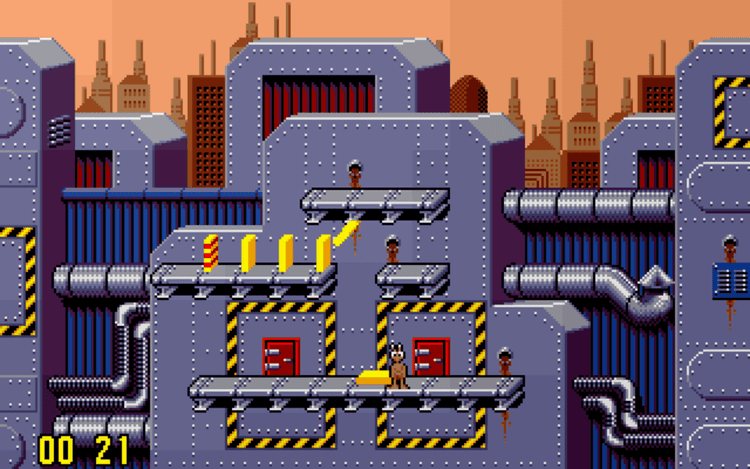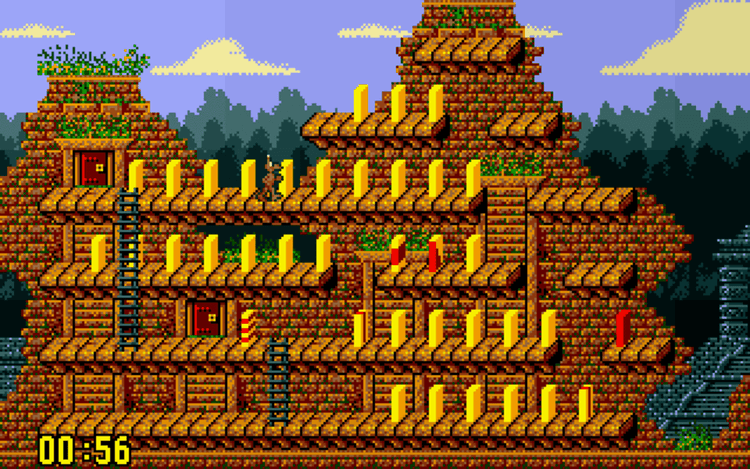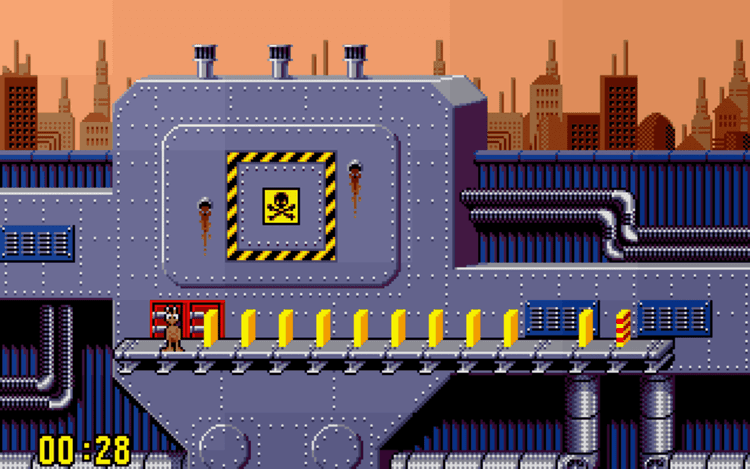
Push-Over is a clever puzzle game published by Ocean Software that stars G.I. Ant, a helmet-clad hero tasked with toppling lines of bright dominoes to unlock each exit. Every stage offers a compact brain-teaser, demanding the planning finesse found in Lemmings and the satisfying chain reactions of The Incredible Machine. Simple one-key controls invite newcomers, while escalating layouts reward patient strategy and experimentation. Because every domino has a unique twist, no two attempts feel identical, ensuring enduring replay appeal. Enjoy the timeless challenge online today and rediscover why thoughtful play never goes out of style.
Released at the dawn of the 1990s by the prolific British publisher Ocean Software, Push-Over distilled the simple pleasure of watching dominoes fall into a thoughtful, level-based puzzle experience. Players guide G.I. Ant—an earnest soldier-ant whose stature belies enormous determination—through a sprawling underground complex filled with colored dominoes, hidden passageways, and surprising chain reactions. Although the game originally promoted a popular snack food, its enduring reputation rests entirely on its inventive mechanics, cheerful presentation, and the perennial thrill of solving a conundrum through careful observation and experimentation.
Push-Over’s genius lies in the way it transforms familiar household objects into a cerebral playground. Each domino type introduces a distinct rule—sliding, exploding, delaying, or splitting momentum—requiring players to visualize a miniature Rube-Goldberg machine before a single tile is tipped. Success demands a blend of logic, spatial reasoning, and sometimes daring improvisation when a chain reacts in unexpected fashion. Unlike many puzzle games that rely on timer pressure, this game encourages deliberate planning: the pace is set entirely by the player, allowing every domino arrangement to unfold like a miniature engineering feat. Because every stage ends once every tile has safely fallen, victory always feels earned, producing that satisfying “aha” moment puzzle fans crave.
While dominoes are the mechanical heart, G.I. Ant provides Push-Over’s soul. The diminutive protagonist scurries, jumps, and pushes with an endearing work-ethic that makes even repeated attempts enjoyable. Brief cut-scenes establish a light-hearted narrative about recovering scattered snacks for a canine friend, giving purpose without overshadowing the puzzles. Bright, smoothly animated sprites and jaunty music further heighten the mood, proving that technical limitations never hindered personality. The intuitive, responsive controls let players focus on chain-reaction strategy rather than dexterity, ensuring that challenge always emerges from mental gymnastics instead of twitch reactions. Over time, familiarity with G.I. Ant’s precise movement breeds mastery, turning each room into a personal laboratory of domino physics.
Modern enthusiasts can play Push-Over online completely free, launching the game in a web browser without downloads, installations, or geographical restrictions. Thanks to faithful emulation, the original audiovisual style remains intact while adapting seamlessly to laptop keyboards, touchscreens, and external controllers. Whether on a desktop monitor, a tablet propped on a café table, or a phone held in portrait orientation, the clear tile graphics and unhurried pacing translate effortlessly to every screen size. Short levels make the game perfect for quick sessions during commutes, yet the deeper challenge invites marathon play on a lazy weekend. Because progress is contained within each self-contained puzzle, hopping in and out feels natural, making Push-Over an ideal companion for puzzle lovers seeking a portable mental workout.
Decades after release, Push-Over still earns praise from designers who cite its ruleset as an early example of emergent gameplay—simple components combining to create surprising complexity. Its domino specialization anticipated later physics-driven titles, while the clarity of its objectives mirrors contemporary mobile puzzle hits. Communities continue to devise alternate solutions, speed-run categories, and even fan-made levels, testifying to an evergreen design that resists obsolescence. Aesthetically, the game’s understated palette and charming sprite work feel refreshingly timeless, sidestepping the aging pitfalls of realism. Whether discovering it for the first time or returning for nostalgic comfort, players find that the core appeal—seeing an intricate chain fall flawlessly—remains as engrossing today as ever.
The journey through Push-Over’s 100 stages builds confidence methodically: new domino types appear, combine, and eventually converge into sprawling sequences that can test the most seasoned strategist. Yet failure never stings, because resetting a layout is instantaneous and experimentation often sparks creative breakthroughs. Few puzzle games capture the same balance between accessibility and depth, making Push-Over a standout in the genre’s history and an inviting gateway for newcomers interested in logic-based entertainment.
At its conclusion, Push-Over leaves players with a renewed appreciation for patience, precision, and the quiet satisfaction of solving a challenge on one’s own terms. Guiding G.I. Ant is performed entirely with directional inputs and a single button to push the chosen domino; mastering the subtleties of positioning, timing, and path-finding becomes second nature long before the final cascade tumbles into place.
All codes used in Push-Over are publicly available, and the game remains the property of its original authors.
Share game
Share game








Share game